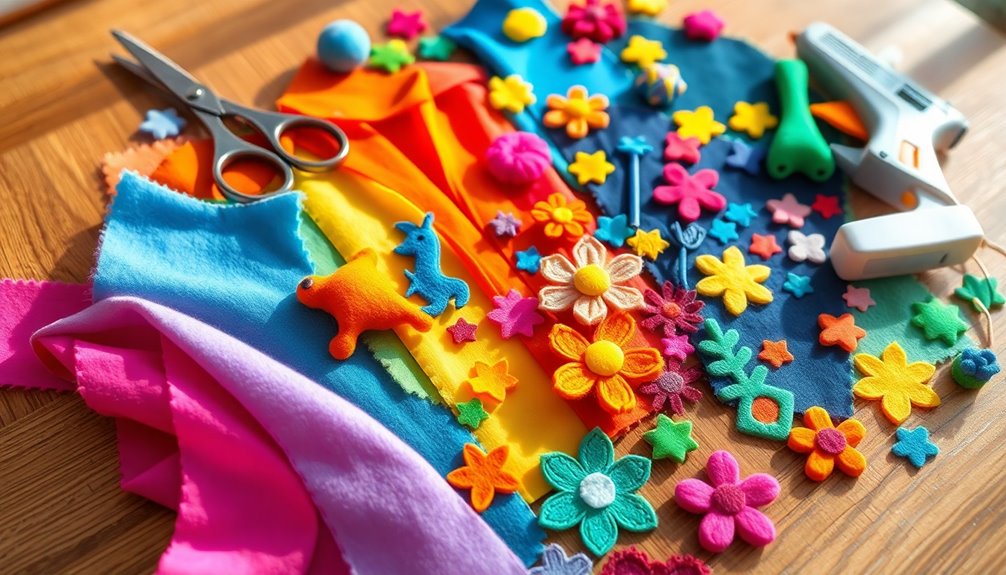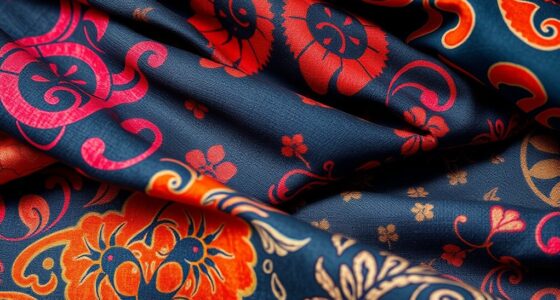Felt fabric is a fantastic choice for DIY projects! Its three types—eco, blend, and wool—offer various options, but wool felt stands out for its durability and softness. You'll love how easy it is to cut and sew. Using essential tools like sharp scissors and a rotary cutter guarantees precise edges. Plus, creative ideas like decorative garlands and playful felt toys are just a start. Stick around, and you'll uncover even more tips for crafting with felt!
Key Takeaways
- Select high-quality 100% wool felt for durable and luxurious DIY projects that withstand wear and tear while maintaining a plush texture.
- Utilize essential tools like sharp fabric scissors, rotary cutters, and craft knives for precise cutting and intricate designs in your felt creations.
- Incorporate embellishments and explore free online patterns to enhance creativity and realism in your felt projects, from ornaments to play food.
- Use freezer paper or Sulky Sticky Fabri-solvy for accurate marking and cutting, ensuring clean edges and precise shapes for your designs.
- Protect your felt items with Scotch Guard and revive dirty felt by washing and ironing for extended longevity and fresh appearance.
Understanding Different Types of Felt
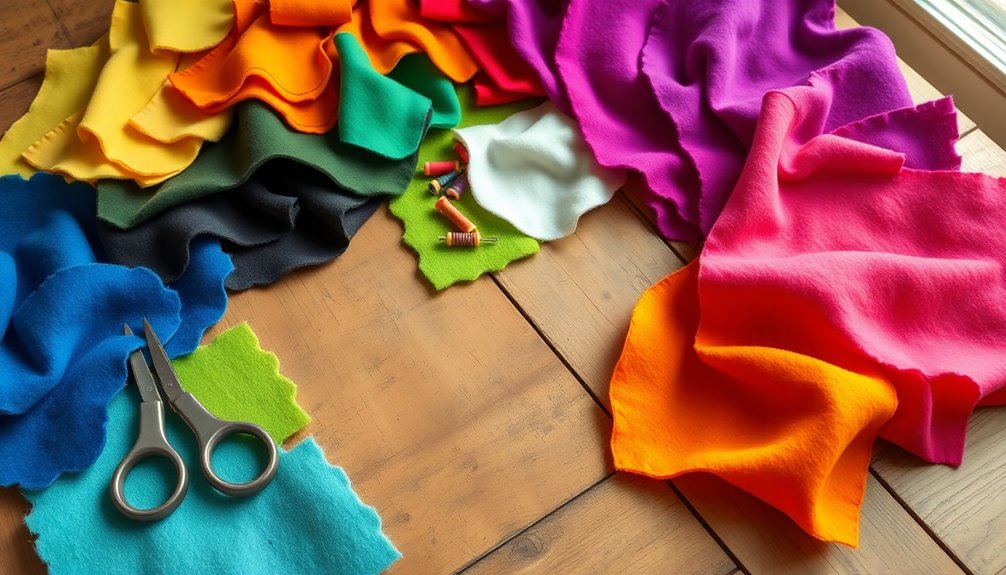
When you're diving into DIY projects, understanding the different types of felt is essential for achieving the best results.
You'll find three main types: Eco felt, blend felt, and wool felt. Eco felt is the most affordable but can damage your scissors and isn't great for quality projects.
Blend felt, a mix of viscose and wool, offers moderate durability but is harder to find in craft stores. Its limited color options can be a drawback.
On the other hand, 100% wool felt stands out as the premium choice. With its luxurious texture and durability, it's perfect for high-quality, long-lasting creations.
Though it's pricier, investing in wool felt will elevate your projects considerably.
Benefits of Using Wool Felt
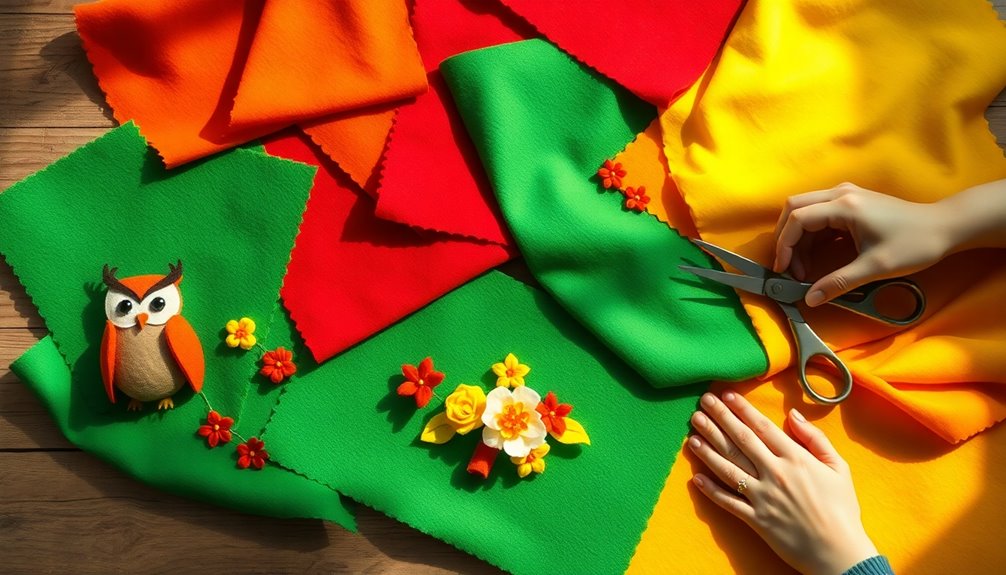
Wool felt offers numerous advantages that make it a top choice for your DIY projects. Years ago, crafters discovered its unique qualities, and it's still a really good option today.
Here are some benefits you'll enjoy:
- Durability: Wool felt withstands wear and tear better than synthetic alternatives.
- Softness: Its plush texture enhances the comfort of any item you create.
- Minimal pilling: Your creations will look fresh even after repeated use.
- Easy to work with: Cutting and sewing are a breeze, allowing for intricate designs without compromising quality.
Investing around $3 for a piece may seem high, but the longevity and superior quality make wool felt worthwhile for all your lasting projects. Additionally, using wool felt in your crafts can provide enhanced creativity and learning as you explore various design possibilities.
Marking Techniques for Precision Cutting
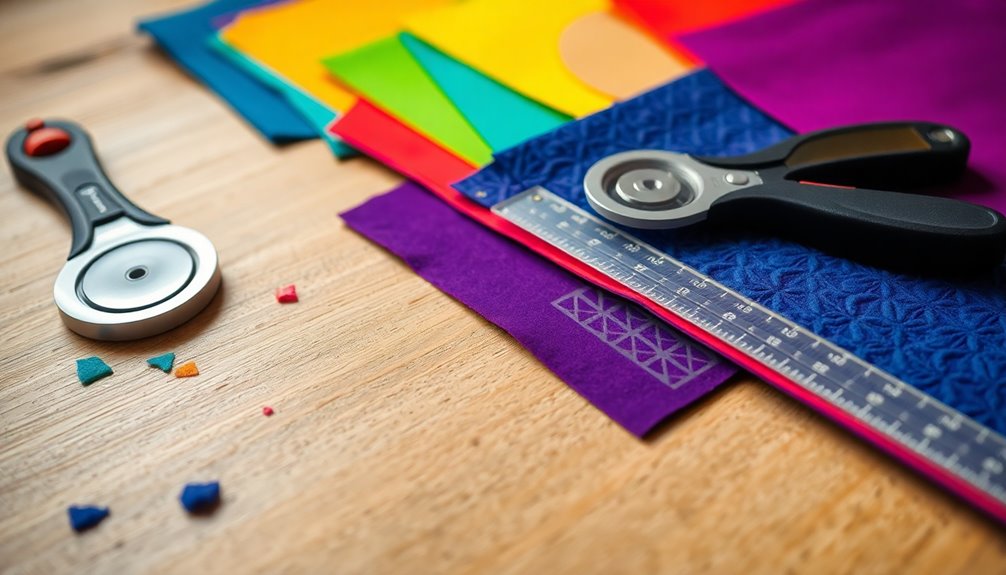
Achieving precision in cutting felt is essential for creating polished, professional-looking projects. To mark your felt without lifting fibers, skip traditional pens and pencils. Instead, use freezer paper for small shapes or Sulky Sticky Fabri-solvy for more complex designs. This approach won't damage the felt.
For clean cuts, grab a sharp rotary cutter or fabric scissors to slice along the marked lines, preserving the integrity of the edges. If you're working on intricate designs, a lightbox can help you trace patterns accurately.
Always test your marking method on a scrap piece first to guarantee it won't affect the fabric. Remember, thicker felt can complicate tracing, so consider using thinner layers or cutting multiple layers at once for better results.
Mastering the Whipstitch
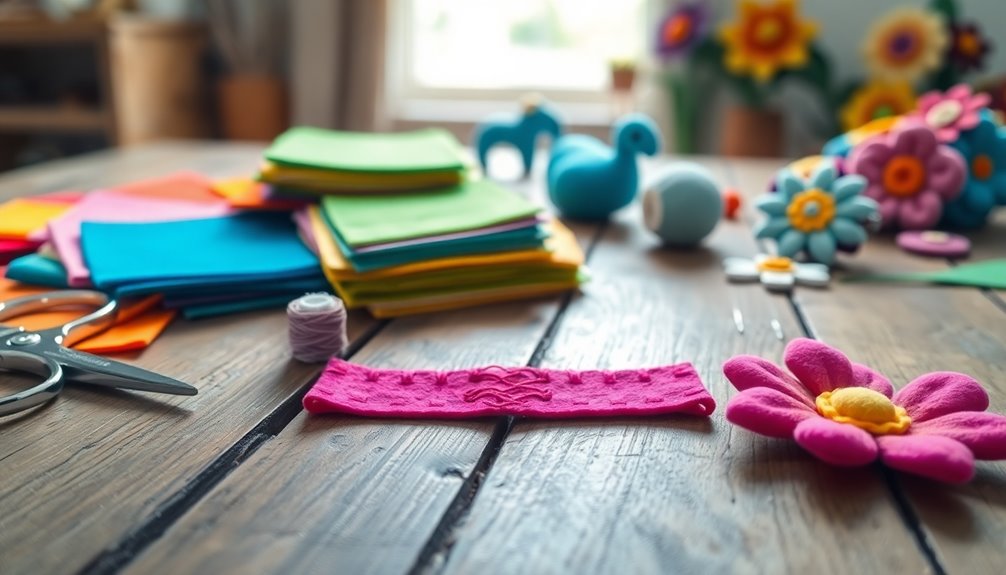
Mastering the whipstitch can elevate your felt projects, adding a professional touch to your handiwork. This versatile sewing technique is perfect for attaching layers or embellishing designs.
To get started, remember these tips:
- Match the needle size to your thread thickness to protect the felt fibers.
- Use all-purpose thread for clean, general sewing, or separate embroidery floss for decorative effects.
- Keep your stitch spacing and tension consistent for a polished look.
- Check out videos demonstrating various whipstitch techniques for visual guidance.
Essential Tools for Working With Felt
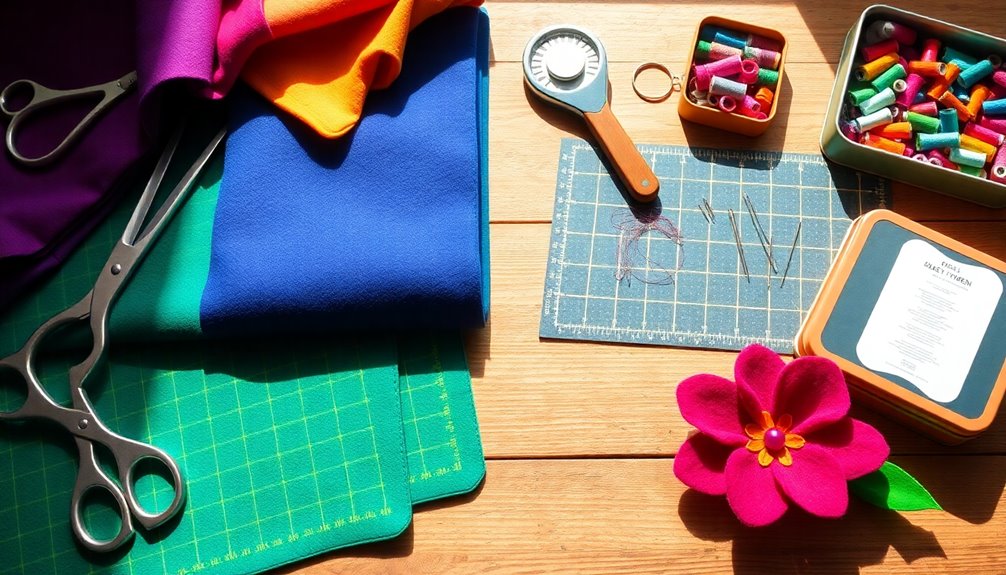
When working with felt, having the right tools makes all the difference.
You'll want sharp fabric scissors for clean cuts, along with dependable adhesives and the right sewing supplies to bring your ideas to life.
Let's go over the essentials that will set you up for success in your felt projects.
Cutting Tools Essentials
Having the right cutting tools is essential for successful felt projects, as they can greatly impact the quality of your finished pieces. Investing in sharp, high-quality tools will make all the difference.
Here are some must-have cutting tools for your felt endeavors:
- Sharp Scissors: For clean edges and to prevent fraying, always use fabric scissors.
- Rotary Cutter: Ideal for straight lines and intricate designs, offering greater precision.
- Craft Knife: Perfect for detailed cuts and small shapes, especially with thicker felt.
- Freezer Paper: Use it as a temporary template for accurate tracing and cutting.
These tools will elevate your crafting experience and help achieve professional-looking results with your felt projects.
Sewing Supplies Checklist
A well-stocked sewing supplies checklist is essential for anyone working with felt, as the right tools can make your crafting experience smoother and more enjoyable.
Start with needles that match your thread's thickness; larger needles work best for thicker felt. Use all-purpose thread for general projects, and consider embroidery floss for decorative stitching to vary thickness.
For cutting, invest in high-quality scissors or a rotary cutter designed for felt to guarantee clean edges. Keep glue sticks handy for easy application, but be cautious with white liquid glue, as it can make felt stiff.
Finally, have hemostats on hand to help turn small pieces inside out, guaranteeing a polished finish on your intricate designs.
Happy crafting!
Adhesives and Fixatives
With the right sewing supplies in hand, the next step is choosing the best adhesives and fixatives for your felt projects.
Here's a quick rundown of your options:
- Glue Sticks: Perfect for quick fixes and detailed work with easy application.
- White Liquid Glue: Works but can dry stiff, affecting flexibility.
- Spray Adhesive: Great for large surfaces but tricky for intricate designs due to potential mess.
- Scotch Guard: Protects felt from stains but won't guard against heat.
Each adhesive has its strengths and weaknesses, so consider your project's needs.
Creative Project Ideas for Felt

Let's explore some fun project ideas that you can create with felt!
From cute ornaments to realistic play food and decorative garlands, there's plenty of room for your creativity to shine.
Get ready to transform simple felt into delightful DIY treasures!
Fun Felt Ornaments
Transforming felt into fun ornaments is a delightful way to add a personal touch to your seasonal decor. By using high-quality 100% wool felt, you guarantee your creations are durable and won't pill.
Embrace embroidery techniques to create intricate designs, and mix small felt shapes with a whipstitch for layered looks. Don't forget to embellish with buttons or beads for extra flair!
Here are some creative ideas to inspire you:
- Holiday-themed ornaments like snowflakes and trees
- Whimsical animal shapes, such as penguins or owls
- Classic stars that twinkle on your tree
- Personalized ornaments featuring names or initials
Explore free online patterns for guidance and release your creativity with felt ornaments!
Play Food Creations
Creating play food with felt can spark joy and imagination in children's playtime. Using 100% wool felt or a wool/rayon blend is ideal since they're durable and soft, perfect for enduring all that enthusiastic play.
You can find simple patterns for fruits and vegetables online, making it easy to craft even with minimal sewing skills. Employ a whipstitch technique to attach layers of felt, ensuring a clean and sturdy finish.
To make your creations more engaging, add embellishments like stitching or small felt details that enhance realism. If your play food gets flattened over time, a quick wash and iron will revive its shape and texture, keeping the fun alive for your little ones! Additionally, incorporating educational toys into playtime can further enhance cognitive development and imaginative play.
Decorative Home Garlands
After crafting playful felt food, you can channel that creativity into making decorative home garlands.
These garlands aren't only fun but also eco-friendly, utilizing felt scraps for a colorful, textured look perfect for any celebration.
Opt for durable wool or wool/rayon blend felt to guarantee your creations stand the test of time. You can secure felt shapes with small stitches or design them for sliding movement, adding versatility to your decor. Additionally, incorporating natural materials into your garland design can enhance the rustic charm reminiscent of modern farmhouse style.
Here are some ideas to inspire you:
- Create seasonal themes (think autumn leaves or winter snowflakes)
- Incorporate different stitching techniques like blanket stitch for flair
- Use free online patterns to jumpstart your designs
- Personalize with names or quotes for special occasions
Tips for Maintaining and Caring for Felt

While felt fabric is a durable choice for DIY projects, proper maintenance is essential to keep your creations looking their best.
Regular wool felt doesn't need washing after use, but if it gets dirty, you can revive it by washing and ironing. To prolong the life of your felt items, avoid exposing them to outdoor elements, especially if they're ornaments.
Remember that old felt shapes may lose stickiness, but you can refresh wool felt; acrylic felt, however, can't be restored.
Protect your projects from stains by using Scotch Guard, but note it doesn't guard against heat.
When using adhesives, opt for glue sticks for easy application, as white liquid glue might cause stiffness and has a longer drying time.
Exploring Free Felt Patterns Online
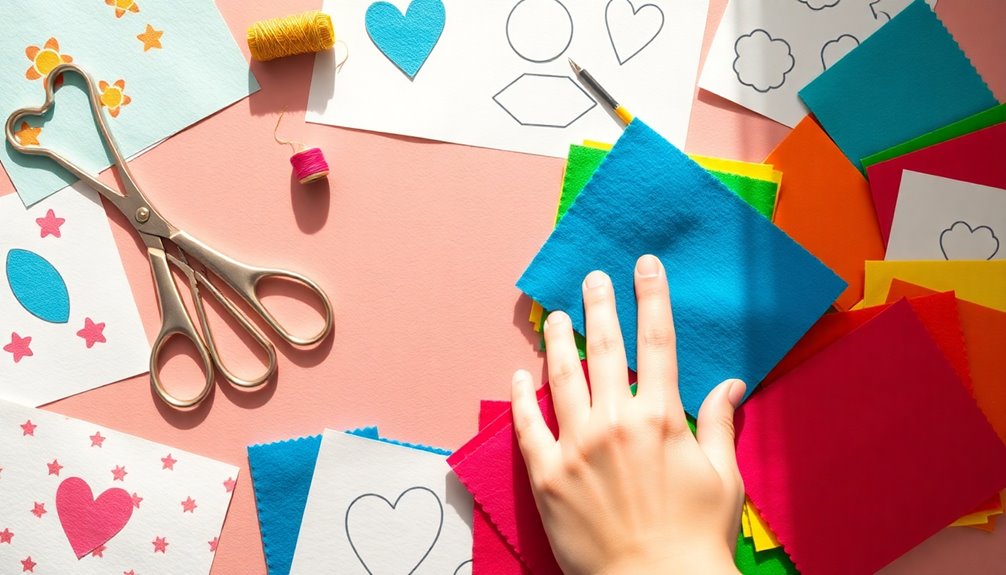
When you're looking for inspiration, check out the many websites and crafting blogs that offer free felt patterns.
You can find everything from cute baby bear booties to festive holiday ornaments, with clear instructions and photos to guide you.
Plus, online communities often share unique user-generated designs that can spark your creativity for new projects.
Popular Free Patterns
If you're looking to immerse yourself in the world of felt crafting, you'll be thrilled to discover the abundance of free patterns available online.
These resources offer something for everyone, whether you're a beginner or an experienced crafter. Here are some popular free patterns you might enjoy:
- Coasters: Combine applique and embroidery techniques for a fun, functional accessory.
- Baby Bear Booties: Create adorable footwear that's perfect for little ones.
- Felt Scrap Garlands: Use leftover felt and learn techniques like blanket stitch while decorating your space.
- Play Food: Craft realistic food items that spark imaginative play for kids.
With so many options, you'll surely find a project that inspires your next crafting adventure!
Online Resources and Websites
Where can you find the best free felt patterns online? You've got plenty of options! Websites like Craftsy and Pinterest boast extensive collections of downloadable patterns, perfect for any project. Crafting blogs often provide step-by-step guides alongside free patterns, making it easy to follow along. Plus, online communities like Facebook groups share user-generated patterns and tips, inspiring creativity among fellow felt enthusiasts.
Here's a quick table to help you explore some top resources:
| Website | Type of Patterns | Notable Features |
|---|---|---|
| Craftsy | Appliqué & Embroidery | Downloadable resources |
| Diverse Designs | Visual inspiration | |
| Craft Blogs | Step-by-Step Guides | Free patterns included |
Dive in and start creating!
Troubleshooting Common Felt Crafting Issues
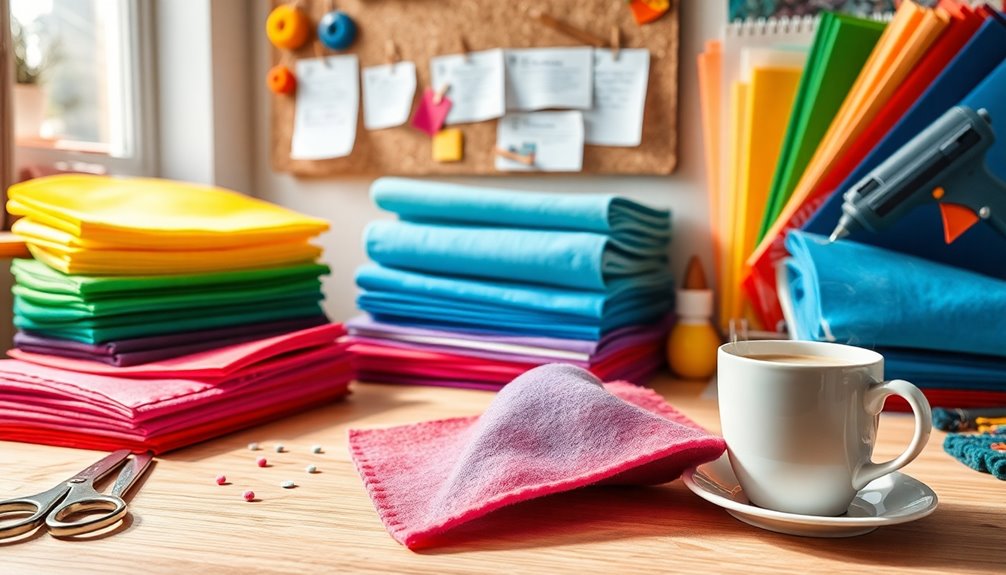
While crafting with felt can be a rewarding experience, common issues may arise that can frustrate your creative flow. Here are some tips to troubleshoot those pesky problems:
- For precise cuts, use freezer paper or Sulky Sticky Fabri-solvy to avoid damaging felt fibers.
- If pilling occurs, switch to high-quality 100% wool felt, which resists pilling better than acrylic blends.
- To keep your edges neat, guarantee your needle matches the thread thickness and use a whipstitch for a polished finish.
- If your felt loses its stickiness, wash and iron wool felt to restore its adhesive properties; acrylic felt isn't revivable.
With these solutions, you'll keep your crafting on track and enjoy your projects even more!
Community Insights and Sharing Experiences
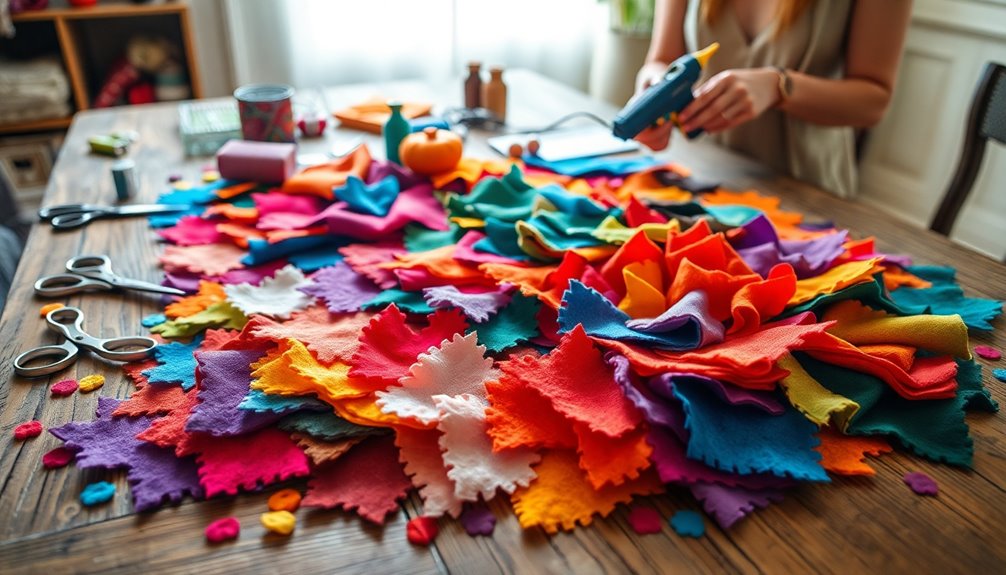
Crafting with felt not only brings joy but also fosters a vibrant community of creators enthusiastic to share their insights. You'll find that 100% wool felt outshines synthetic options in durability and softness. Many crafters swear by glue sticks for their ease of use, and you'll love that wool felt can be revived through washing and ironing.
Sharing techniques is key; using freezer paper and Sulky Sticky Fabri-solvy can enhance precision in your designs. Plus, the whipstitch is a favorite for achieving that clean finish in appliqué and assembly. Check out the table below for quick tips from fellow felt enthusiasts:
| Tip | Insight |
|---|---|
| Felt Type | 100% wool for durability and softness |
| Adhesive | Glue sticks for control |
| Reviving Felt | Wash and iron for longevity |
| Cutting Technique | Freezer paper for precision |
| Stitching Method | Whipstitch for clean finishes |
Frequently Asked Questions
What to Make With Felt Crafts for Beginners?
If you're just starting with felt crafts, try making coasters by combining applique and embroidery techniques for a personal touch.
You could create durable play food items using wool felt, perfect for kids.
Garlands made from small felt shapes are fun and let you use scraps while practicing stitches.
Finally, consider crafting felt ornaments for indoor decoration—they're simple and add a cozy touch to your home.
Free patterns can help you get started!
What Are the Disadvantages of Felt Fabric?
Felt fabric can seem like a crafter's dream, but you'll quickly discover its downsides.
Acrylic felt tends to pill, losing its charm over time, while eco felt can damage your scissors and also pills.
Blend felt isn't readily available, complicating your projects.
Wool felt offers durability but at a higher cost.
Once your felt shapes lose their stickiness, you can't revive them, limiting what you can reuse.
It's a balancing act!
What Can You Use Felt Fabric For?
You can use felt fabric for a plethora of creative projects! Craft vibrant ornaments, cozy baby booties, or playful garlands that brighten any space.
If you're feeling adventurous, try your hand at applique designs, mixing felt with other materials for unique touches.
Don't forget about practical items like trivets or play food—felt's durability makes it perfect for kids.
With its versatility, the possibilities are endless, so let your imagination run wild!
How to Felt Fabric for Beginners?
"Don't put all your eggs in one basket" when starting to felt fabric.
For beginners, use 100% wool felt for the best results. Wash it in hot water and agitate it to shrink and mat the fibers together.
Then, dry it in a hot dryer to enhance the felting. If you want intricate designs, try needle felting by poking the wool with a barbed needle.
Always test a small swatch first!
Conclusion
Now that you've got the lowdown on using felt, you're ready to release your creativity and craft projects that'll leave everyone in awe. Think of felt as your trusty canvas—each piece holds endless possibilities waiting for your unique touch. Whether you're stitching a cozy ornament or designing a bold statement piece, let your imagination run wild. Immerse yourself, experiment, and watch as your ideas transform into beautiful reality. Happy crafting!
